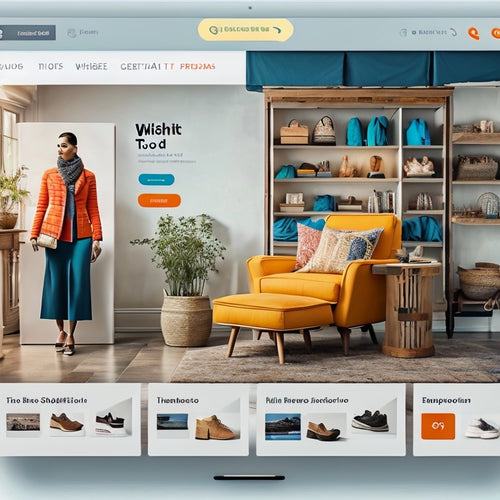
Inventory Planner Integrations Drive Retail Success
Share
Effective inventory planner integrations are a vital factor in driving retail success, as they enable the seamless flow of critical data and facilitate data-driven decision-making across various business systems. Real-time data access empowers retailers to respond promptly to changes in demand, optimizing inventory levels and enhancing customer experience. By integrating with critical business systems, retailers can reduce manual errors, streamline inventory processes, and improve forecasting accuracy. With accurate and timely data, retailers can identify areas of improvement and make informed decisions that drive business growth. By synchronizing data across systems, retailers can tap into the full potential of their inventory planner and Stay ahead of the competition.
Key Takeaways
• Inventory planner integrations facilitate seamless data synchronization, enabling retailers to make data-driven decisions and drive business growth.
• Real-time data access allows retailers to promptly respond to changes in demand, optimizing inventory levels and enhancing customer satisfaction.
• Automation of manual processes reduces errors, streamlines inventory management, and frees up resources for strategic planning and growth.
• Integrations with critical business systems provide a unified data landscape, enabling informed decision-making and improved forecasting accuracy.
• Data-driven insights from integrations identify areas of improvement, empowering retailers to refine their strategies and stay ahead of the competition.
Unlocking Inventory Planner Potential
By integrating Inventory Planner with other critical business systems, retailers can harness the full potential of their inventory management capabilities, gaining a competitive edge through real-time data and enhanced retail performance. This synergy enables retailers to maximize efficiency by automating tasks, reducing manual errors, and streamlining inventory processes.
Additionally, integrating Inventory Planner with sales and demand data allows for improving forecasting accuracy, ensuring ideal inventory levels, and minimizing stockouts or overstocking. By leveraging real-time insights, retailers can respond swiftly to changing market conditions, making data-driven decisions to drive business growth.
With Inventory Planner integrations, retailers can tap into the full potential of their inventory management capabilities, driving retail success.
Seamless System Integrations Matter
Effective system integrations are the linchpin of a harmonious and high-performing retail ecosystem, as they facilitate the free flow of critical data between Inventory Planner and other business systems. This seamless connection enables data optimization, allowing retailers to make informed decisions and drive business growth.
Unified data landscape: Integrations create a single source of truth, eliminating data silos and ensuring accuracy.
Streamlined operations: Automated data exchange reduces manual errors, freeing up resources for strategic activities.
Enhanced analytics: Real-time data synchronization enables retailers to respond quickly to changing market conditions, optimizing inventory levels and improving customer satisfaction.
Retail Success Through Data Sync
Retailers that harness their data in real-time can access a granular understanding of their operations, empowering them to make data-driven decisions that drive business growth and customer satisfaction.
By leveraging inventory planner integrations, retailers can achieve seamless data synchronization, enabling data optimization and retail efficiency. This synchronization enables retailers to respond promptly to changes in demand, optimize inventory levels, and streamline logistics.
With real-time insights, retailers can identify areas of improvement, reduce costs, and enhance the overall customer experience.
Frequently Asked Questions
Can I Customize Integrations to Fit My Business's Unique Needs?
"Did you know that 70% of businesses cite integration as a major obstacle to digital transformation? Fortunately, our experts work closely with you to understand your business requirements, leveraging technical flexibility to craft tailored integrations that meet your unique needs."
How Do I Ensure Data Accuracy During the Integration Process?
To guarantee data accuracy during integration, implement rigorous data validation protocols and conduct regular integration audits to detect and rectify discrepancies, ensuring seamless data synchronization and reliable insights.
Are There Any Additional Fees for New Integrations or Updates?
When evaluating new integrations or updates, conduct a thorough cost analysis to assess budget impacts, ensuring a clear understanding of additional fees and their justification, thereby optimizing integration investments and minimizing unforeseen expenses.
What Kind of Support Is Offered for Integration Maintenance and Issues?
For integration maintenance and issues, our dedicated support team provides Priority Assistance, ensuring prompt resolution. Technical Escalation protocols are in place to address complex issues, ensuring seamless operations and minimizing downtime.
Can I Request a Specific Integration Not Currently Listed?
'Can the boundaries of integration be pushed further?' Yes, we welcome requests for new integrations not currently listed, and our experts will assess feasibility, adding them to our Integration Roadmap, expanding New Possibilities for your business.
Related Posts
-
Shopify SEO: A Simple Guide for Beginners
This article provides a comprehensive guide on Shopify SEO for beginners. It explores the benefits of implementing S...
-

How Do You Optimize for Speed in Shopify Stores
Speed optimization is a crucial aspect to consider in Shopify stores, as it offers numerous benefits. This article a...
-

The Importance of Wishlist Functionality and App Options for Shopify
This article explores the significance of wishlist functionality and the various options available for implementing ...

